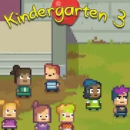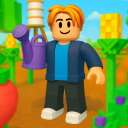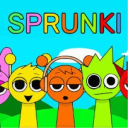Kindergarten 3
Chaos Returns with Bigger Twists, Darker Humor, and Sharper Puzzles
There are few series that manage to balance satire, absurdity, and tight gameplay mechanics quite like the Kindergarten games. With the arrival of Kindergarten 3, developer Con Man Games raises the stakes once again, offering a darkly comedic sequel that refuses to pull punches. If you've followed the franchise, you know what to expect: bizarre characters, layered narrative paths, and a schoolyard that’s anything but ordinary. But even for newcomers, this game provides a self-contained, wildly entertaining adventure full of surprises at every turn.
This isn’t a game about crayons and nap time. It’s a strategy-rich puzzle title that asks you to think critically, explore every dialogue tree, and exploit every opportunity across multiple branching paths. With a larger cast, improved mechanics, and deeper narrative beats than ever before, Kindergarten 3 solidifies its place as one of the most unique indie experiences you can download and play today.
More Twists, More Trouble, More Tactics
Returning players will immediately notice that Kindergarten 3 expands its universe while maintaining the familiar loop: you wake up, go to school, and attempt to survive the chaos through cunning choices and clever manipulation. This time, the setting moves to a mysterious experimental academy designed to “fix” broken students. Naturally, things spiral into madness faster than you can finish your first apple.
The story structure follows a mission-based format, much like its predecessor. Each mission revolves around specific characters and objectives, often requiring the completion of other missions first to unlock the necessary tools or knowledge. This design encourages experimentation, replaying days with different actions, and testing what’s possible with new information. It’s as much a puzzle game as it is an adventure, rewarding critical thinking and creative problem-solving.
Expanded Interactions and Smarter Design
Where Kindergarten 2 added more complex paths and settings, Kindergarten 3 refines that complexity into a more focused experience. The gameplay is less about randomness and more about precision. Every item, every conversation, and every decision counts. You’re constantly gathering clues, collecting tools, and planning the most efficient route through a maze of consequences. It’s this interwoven design that makes each successful day feel earned.
Mechanically, the game runs more smoothly than previous entries. Interface upgrades, a cleaner inventory system, and improved save options make it easier to explore all the content without frustration. For those who like to try different approaches, the new rewind feature makes experimenting easier without forcing full restarts. It also works great on portable platforms and emulator setups, allowing players to enjoy the game on a variety of devices, including unblocked access in web-friendly builds.
Writing That Bites—In the Best Way
The real strength of Kindergarten 3 lies in its writing. The characters are absurd, exaggerated, and often outrageous—but never lazy. Whether it’s the overbearing principal, the shady janitor, or the students with way too much going on for elementary schoolers, every personality in this game is crafted with care and a surprising amount of depth. The humor is sharp, the timing is spot-on, and the ability to twist a simple school activity into something outlandishly complex is unmatched.
This is a game that thrives on its tone. It’s weird, dark, and sometimes uncomfortable—but always with a purpose. That unique voice is what makes the Kindergarten series so iconic, and it’s what keeps this third installment from feeling like more of the same. The developers clearly understand what makes their world tick, and they’ve leaned fully into it.
Visuals, Sound, and Style
Visually, Kindergarten 3 stays consistent with the series’ distinct cartoon look—simple but expressive, colorful yet unsettling. Characters are animated in a deliberately awkward style that suits the game’s off-kilter tone. The backgrounds are packed with details and secrets, and you’ll often find clues hidden in plain sight if you’re observant.
The soundtrack complements the experience perfectly. Playful yet ominous, it shifts tones depending on the context of your actions. Dialogue is not voiced, but the pacing and writing make it easy to follow, with well-crafted sound effects adding tension and humor to key moments.
Freedom to Explore, But No Easy Wins
While it’s technically possible to rush through some missions, Kindergarten 3 heavily encourages players to experiment and absorb the full scope of its design. There’s no fast-track to completion—each day must be handled with precision. This also makes it a rewarding game to revisit with community-created guides or mods, which offer extra challenges or new character paths depending on your platform.
As with prior titles, cheats are unofficial and mostly mod-based, allowing access to all items or bypassing certain triggers. These are helpful for content creators or players looking to test hidden paths, but for most, the base experience is more satisfying when played without shortcuts.
Final Verdict
Kindergarten 3 might seem like a niche indie title, but its unique blend of puzzle-solving, character-driven storytelling, and dark comedy makes it one of the most memorable entries in its genre. Whether you’re here for the secrets, the satire, or just to see how ridiculous a school day can get, this game delivers on every front. It’s not for everyone—but for those who get the humor and enjoy the challenge, it’s an experience you won’t forget anytime soon. And the best part? It’s easier than ever to install, whether you’re playing on a full rig or just squeezing in a quick session through an unblocked browser version at school.
How to download Kindergarten 3
Kindergarten 3 is available for PC via Steam and several indie storefronts. At the time of writing, it's not free but may be discounted during seasonal sales. A free demo may be available depending on the platform. No mobile release exists yet, though unofficial Android versions can be played via emulators.
You can download the game directly from Steam or install it through third-party platforms like itch.io where supported. After purchase, simply install the client, launch, and play. The game has minimal system requirements: 4GB RAM, 1GHz processor, and integrated graphics will run it fine on both PC and Mac.
While official cheats aren't provided, mods are available through community hubs, offering custom items, altered missions, and additional content. If you're trying to access the game in restricted environments, browser-based unblocked versions exist but may not reflect the full game.
Pros
- Extremely clever mission structure with strong cause-effect mechanics;
- Unique art style and memorable character designs;
- Smart, irreverent humor with thoughtful narrative layers;
- Highly replayable with branching paths and multiple endings;
- Improved UI and gameplay systems make it more accessible;
- Mod support extends game longevity and customization options;
- Available on multiple platforms, including potential unblocked setups;
- Tight audio design that matches the game’s tone;
Cons
- No official mobile version yet;
- Repetitive trial-based puzzles may frustrate some players;
- Some characters and missions could have deeper resolution;
- Unmodded gameplay can feel linear until more missions unlock;
- Lack of voice acting may reduce immersion for new players;
- Unblocked/browser access not yet fully available;

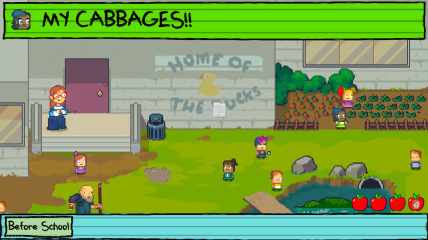
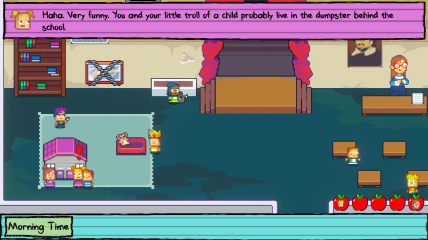
Kindergarten 3
To download the app, you will get links to the Official Website and/or official digital markets.
